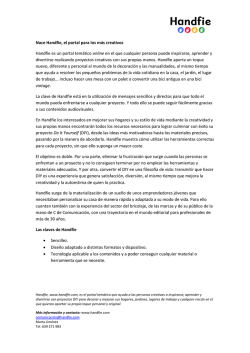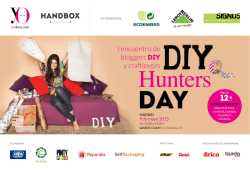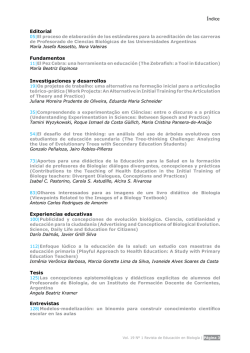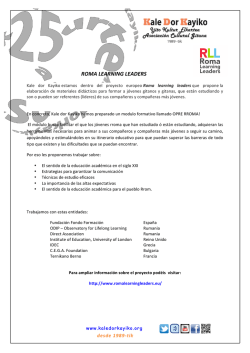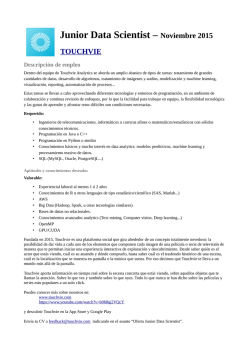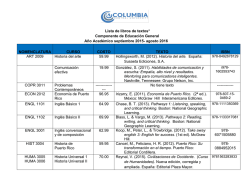
DIY Lab y la innovación docente en la Universidad
DIY Lab y la innovación docente en la Universidad Juana M. Sancho Gil Cristina Alonso Cano © 2014-2015 — DIYLab — Do It Yourself in Education: Expanding Digital Competence To Foster Student Agency And Collaborative Learning. Parcialmente financiado por la European Commission. Lifelong Learning Programme. Education, Audiovisual and Culture Executive Agency. 543177-LLP-1-2013-1-ES-KA3MP Disclaimer: This document reflects the view only of the authors, and the European Commission cannot be held responsible for any use which may be made of the information contained therein. Socios La culturaDIY (hazlo por ti mismo) Culturas juveniles (Buckingham, 2007) Crear, compartir y aprender en colaboración (McKay, 1998, Spencer, 2005 Guzzetti, Elliott, & Welsch, 2010, Kafai & Peppler, 2011) Mezcla de artes, artesanía y tecnologías digitales (Eisenberg & Buechley, 2008; Lankshear & Knobel, 2010). Connectivismo (Siemens, 2008; Kop & Hill, 2008) De consumidores a productores Gran impulso desde la década de 1990 (McKay, 1998) (Spencer, 2005) (Eisenberg & Buechley, 2008) (Guzzetti, Elliott & Welsch, 2010) (Lankshear & Knobel, 2010) (Kafai & Peppler, 2011) 1. Creatividad 2. Colaboración Transformar las culturas docentes 3. Autorregulación Promover el 4. Competencia digital aprendizaje a lo largo, lo ancho y lo profundo de la vida Metodología: Investigación en la acción colaborativa (Reason and Bradbury, 2001) Steps 1 and 2 Design Steps 3 nd 4 Implementation Steps 5 and 6 Evaluation and improvement •WP1 Building DIYLab from participants’ experience and expertise •WP2 Formation in support of DIY Education and design of the DIY Lab E X T E R N A L •WP3 Launch Digital Hub •WP4 DIY Labs in Action at School and Higher Education Q U A L I T Y • WP5 Building on experience: making improvements to the DIY Lab • WP6 Socio-economic evaluation A S S U R A N C E WP10 La dureza de los límites institucionales Encontrando las posibilidades Facultades Grados Asignaturas Profe/estud. Educación Bellas Artes •Pedagogía •Educación Social •Maestro de E. Infantil y Primaria •Bellas Artes •Obligatorias: 9 •Profesores: 21 •Optativas: 1 •Estudiantes: 365 Objetos dig. 76 Desde los estudiantes • Establecer conexiones y transferencias entre diferentes disciplinas y campos del pensamiento. • Integrar los procesos de aprendizaje, reflexionar sobre ellos, representarlos y compartirlos. • Desarrollar un método, una forma de hacer. • Combinar diferentes competencias: análisis, observación, planificación y estructuración de contenidos. • Ser capaz de sentirse integrado, reconocido y motivado. • Tomar de conciencia de sí mismo, no sentirse limitado por algo impuesto. • Aumentar la autonomía de las personas autónomas. • Mejora de la participación y el aprendizaje significativo. • Fomenta la creatividad y dar a conocer su potencial • Sensación de apertura, libertad, responsabilidad y conciencia de sí mismo. • La autorregulación del aprendizaje. • Necesidad de acompañar con mayor intensidad a los menos autónomos. • La actitud inicial de algunos estudiantes, la dificultad de asumir los cambios. • La rigidez de los espacios y los tiempos. • Dificultad de docentes y estudiantes para cambiar sus roles. Referencias ● Buckingham, D. (2007). Beyond Technology: Children's Learning in the Age of Digital Culture. Cambridge: Polity Press. ● Denzin, N. (1997). Interpretative Ethnography. Thousand Oaks, CA: Sage ● Eisenberg, M. & Buechley, L. (2008). Pervasive Fabrication: Making Construction Ubiquitous in Education. Journal of Software, 3(4), 62– 68. doi:10.4304/jsw.3.4.62-68 ● Giró, X. (2014) Presentación del DIYLab. Esbrina Research Group. University of Barcelona. Retrieved from http://diylab.eu/docs/Presentacio_DIYLab.pdf ● Guzzetti, B., Elliott, K. & Welsch, D. (2010). DIY Media in the Classroom. New York, NY: Teachers College Press. ● Green, J. L., Camill, G. & Elmore, P. B. (2006). Handbook of Complementary Methods in Education Research. Routledge AERA. ● Kafai, Y. B. & Peppler, K. A. (2011). Developing Participatory Competencies in Creative Media Production. Review of Research in Education, 35(1), 89-119. doi: 10.3102/0091732x10383211 ● Kop, R. & Hill. A. (2008). Connectivism: Learning theory of the future or vestige of the past? The international Review of Research in Open and Distributed Learning, 9(3). Retrieved from http://www.irrodl.org/index.php/irrodl/article/viewArticle/523/1103%2522. ● Lankshear, M. & Knobel, C. (Eds.). (2010). DIY media. Creating, sharing and learning with new technologies. New York, NY: Peter Lang ● McKay, G. (1998). DIY culture: Notes towards an intro. In G. McKay (Ed.), DIY Culture: Party and Protest in Nineties Britain (pp. 1-53). London: Verso ● Reason, P. & Bradbury, H. (2001). Handbook of action research. Participative inquiry and practice. London: Sage. ● Siemens, G. (2008). Learning and knowing in networks: Changing roles for educators and designers. Paper 105: University of Georgia IT Forum. Retrieved from http://it.coe.uga.edu/itforum/Paper105/Siemens.pdf ● Spencer, A. (2005). DIY. The rise of Lo-Fi culture. London: Marion Boyars. http://ub.edu http://esbrina.eu ¡¡¡ GRACIAS!!! http://www.ub.ed/indagat/ http://reunid.eu/
© Copyright 2025
